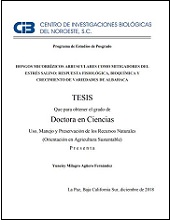Mostrar el registro sencillo del ítem
Hongos micorrízicos arbusculares como mitigadores del estrés salino: respuesta fisiológica, bioquímica y crecimiento de variedades de albahaca
| dc.contributor | Bernardo Murillo Amador | |
| dc.contributor | Luis Guillermo Hernández Montiel | |
| dc.creator | Yuneisy Milagro Agüero Fernández | |
| dc.date | 2018-12 | |
| dc.identifier | http://cibnor.repositorioinstitucional.mx/jspui/handle/1001/1482 | |
| dc.identifier.uri | http://dspace.cibnor.mx:8080/handle/123456789/2831 | |
| dc.description | "El objetivo del estudio fue evaluar hongos micorrízicos arbusculares como mitigadores del estrés salino: respuesta fisiológica, bioquímica y crecimiento de variedades de albahaca (Ocimum basilicum L.) cv. Nufar, Genovese y Napoletano con respuesta diferencial al estrés por NaCl. La investigación se realizó en condiciones de invernadero. Para las etapas emergencia, crecimiento inicial vegetativo y producción, se aplicó un diseño completamente aleatorio con arreglo factorial considerando factor 1, variedades de albahaca, factor 2, la concentración de sal (0, 50 y 100 mM de NaCl) y factor 3, la presencia o ausencia de HMA (0 y 1 g de inóculo en emergencia y 0 y 10 g inóculo en crecimiento inicial vegetativo y producción), con cuatro repeticiones por tratamiento. Las variables de respuesta evaluadas fueron, para primera etapa experimental, el porcentaje y tasa de emergencia, altura de plántulas, longitud de la raíz, la biomasa fresca y seca de la parte aérea y la raíz, el análisis químico del sustrato se realizó para las tres etapas experimentales. En la segunda y tercera etapa experimental se evaluó a cada cosecha, el contenido relativo de agua, potencial hídrico, área foliar, biomasa fresca y seca de parte aérea y de raíz, longitud de raíz, altura de plantas, tasa fotosintética, número de esporas y porcentaje de colonización micorrízica. En la tercera etapa además de las variables anteriormente mencionadas se evaluó clorofila a, b, y total, contenido de prolina, proteína total, glutatión peroxidasa en hojas y raíz y contenido de aceite esencial. Los resultados revelaron que el sustrato fue adecuado para las tres etapas. En emergencia los resultados tanto cuando se utilizó Funneliformis mosseae + Claroideoglomus etunicatum que con R. fasciculatum mostraron diferencias en todas las variables siendo Napoletano la variedad que mostró mayores valores en 0, 50 y 100 mM NaCl con HMA. La mayoría de las variables disminuyeron al incrementar las concentraciones de NaCl. No se encontró colonización de la raíz en ninguna plántula inoculada con HMA en esta etapa. En la etapa crecimiento inicial vegetativo se obtuvo que los valores mayores en todas las variables de respuesta correspondieron a plantas inoculadas con R. fasciculatum (T20…50). La interacción variedad × NaCl × HMA fue mayor en las plantas control, con 0 mM NaCl inoculadas con HMA y menor en plantas tratadas con 100 mM NaCl sin HMA..." | |
| dc.description | "The objective of the study was to evaluate arbuscular mycorrhizal fungi as saline stress relievers: physiological, biochemical response and growth of basil varieties (Ocimum basilicum L.) cv. Nufar, Genovese and Napoletano with differential response to stress by NaCl. The research was conducted under greenhouse conditions. For the stages of emergence, initial vegetative growth and production, a completely randomized design was applied with a factorial arrangement considering Factor 1, basil varieties, factor 2, salt concentration (0, 50 and 100 mM NaCl) and factor 3, the presence or absence of AMF (0 and 1 g of inoculum in emergence and 0 and 10 g inoculum in initial vegetative growth and production), with four repetitions per treatment. The response variaties evaluated were, for the first experimental stage, the percentage and emergence rate, height of the seedlings, length of the root, fresh and dry biomass of the aerial part and the root, the chemical analysis of the substrate was carried out for the three experimental stages, In the second and third experimental stage, each crop was evaluated, the relative water content, water potential, leaf area, fresh and dry biomass of aerial part and root, root length, height of plants, photosynthetic rate, number of spores and percentage of mycorrhizal colonization. In the third stage, in addition to the previously mentioned variables, chlorophyll a, b, and total, proline content, total protein, glutathione peroxidase in leaves and root and essential oil content were evaluated. The results revealed that the substrate was adequate for all three stages. In emergencies, results were obtained when Funneliformis mosseae + Claroideoglomus etunicatum was used, which showed differences in R. fasciculatum in all variables, with Napoletano being the variety that showed the highest values in 0, 50 and 100 mM NaCl with AMF. Most of the variables decreased with increasing NaCl concentrations. No colonization of the root was found in any seedling inoculated with AMF at this stage. In the initial vegetative growth stage it was obtained that the highest values in all the response variables corresponded to plants inoculated with R. fasciculatum (T20.... 50). The interaction variety × NaCl × AMF was greater in the control plants, with 0 mM NaCl inoculated with AMF and lower in plants treated with 100 mM NaCl without AMF..." | |
| dc.format | application/pdf | |
| dc.language | spa | |
| dc.publisher | Centro de Investigaciones Biológicas del Noroeste, S. C. | |
| dc.rights | info:eu-repo/semantics/openAccess | |
| dc.rights | http://creativecommons.org/licenses/by-nc-nd/4.0 | |
| dc.subject | info:eu-repo/classification/AUTOR/Hongo micorrízico arbuscular, albahaca, estrés, colonización | |
| dc.subject | info:eu-repo/classification/AUTOR/Arbuscular mycorrhizal fungus, basil, stress, colonization | |
| dc.subject | info:eu-repo/classification/cti/6 | |
| dc.subject | info:eu-repo/classification/cti/31 | |
| dc.subject | info:eu-repo/classification/cti/3103 | |
| dc.subject | info:eu-repo/classification/cti/241719 | |
| dc.subject | info:eu-repo/classification/cti/241719 | |
| dc.title | Hongos micorrízicos arbusculares como mitigadores del estrés salino: respuesta fisiológica, bioquímica y crecimiento de variedades de albahaca | |
| dc.type | info:eu-repo/semantics/doctoralThesis | |
| dc.type | info:eu-repo/semantics/acceptedVersion |


